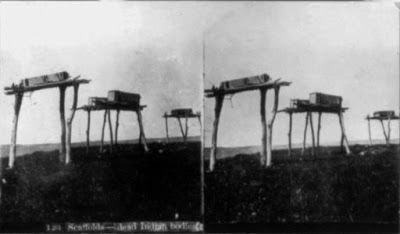TREE AND SCAFFOLD BURIAL.
by Fritz Zimmerman
We may now pass to what may be called aerial sepulture proper, the most common examples of which are tree and scaffold burial, quite extensively practiced even at the present time. From what can be learned the choice of this mode depends greatly on the facilities present, where timber abounds, trees being used, if absent, scaffolds being employed.
From William J. Cleveland, of the Spotted Tail Agency, Nebraska, has been received a most interesting account of the mortuary customs of the Brulé or Teton Sioux, who belong to the Lakota alliance. They are called Sicaugu, in the Indian tongue Seechaugas, or the “burned thigh” people. The narrative is given in its entirety, not only on account of its careful attention to details, but from its known truthfulness of description. It relates to tree and scaffold burial.
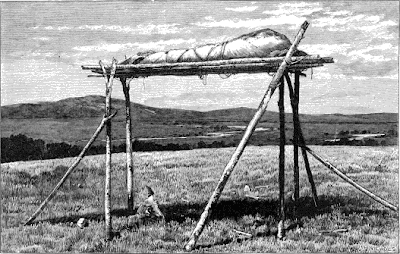
FUNERAL CEREMONIES AND MOURNING OBSERVANCES.
Though some few of this tribe now lay their dead in rude boxes, either burying them when implements for digging can be had, or, when they have no means of making a grave, placing them on top of the ground on some hill or other slight elevation, yet this is done in imitation of the whites, and their general custom, as a people, probably does not differ in any essential way from that of their forefathers for many generations in the past. In disposing of the dead, they wrap the body tightly in blankets or robes (sometimes both) wind it all over with thongs made of the hide of some animal and place it reclining on the back at full length, either in the branches of some tree or on a scaffold made for the purpose. These scaffolds are about eight feet high and made by planting four forked sticks firmly in the ground, one at each corner and then placing others across on top, so as to form a floor on which the body is securely fastened. Sometimes more than one body is placed on the same scaffold, though generally a separate one is made for each occasion. These Indians being in all things most superstitious, attach a kind of sacredness to these scaffolds and all the materials used or about the dead. This superstition is in itself sufficient to prevent any of their own people from disturbing the dead, and for one of another nation to in any wise meddle with them is considered an offense not too severely punished by death.
The same feeling also prevents them from ever using old scaffolds or any of the wood which has been used about them, even for firewood, though the necessity may be very great, for fear some evil consequences will follow. It is also the custom, though not universally followed, when bodies have been for two years on the scaffolds to take them down and bury them under ground.
All the work about winding up the dead, building the scaffold, and placing the dead upon it is done by women only, who, after having finished their labor, return and bring the men, to show them where the body is placed, that they may be able to find it in future. Valuables of all kinds, such as weapons, ornaments, pipes, in short, whatever the deceased valued most highly while living, and locks of hair cut from the heads of the mourners at his death, are always bound up with the body. In case the dead was a man of importance, or if the family could afford it, even though he were not, one or several horses (generally, in the former case, those which the departed thought most of) are shot and placed under the scaffold. The idea in this is that the spirit of the horse will accompany and be of use to his spirit in the “happy hunting grounds,” or, as these people express it, “the spirit land.
When an Indian dies, and in some cases even before death occurs, the friends and relatives assemble at the lodge and begin crying over the departed or departing one. This consists in uttering the most heartrending, almost hideous wails and lamentations, in which all join until exhausted. Then the mourning ceases for a time until some one starts it again, when all join in as before and keep it up until unable to cry longer. This is kept up until the body is removed. This crying is done almost wholly by women, who gather in large numbers on such occasions, and among them a few who are professional mourners. These are generally old women and go whenever a person is expected to die, to take the leading part in the lamentations, knowing that they will be well paid at the distribution of goods which follows. As soon as death takes place, the body is dressed by the women in the best garments and blankets obtainable, new ones if they can be afforded. The crowd gathered near continue wailing piteously, and from time to time cut locks of hair from their own heads with knives, and throw them on the dead body. Those who wish to show their grief most strongly, cut themselves in various places, generally in the legs and arms, with their knives or pieces of flint, more commonly the latter, causing the blood to flow freely over their persons. This custom is followed to a less degree by the men.
A body is seldom kept longer than one day as, besides the desire to get the dead out of sight, the fear that the disease which caused the death will communicate itself to others of the family causes them to hasten the disposition of it as soon as they are certain that death has actually taken place
Until the body is laid away the mourners eat nothing. After that is done, connected with which there seems to be no particular ceremony, the few women who attend to it return to the lodge and a distribution is made among them and others, not only of the remaining property of the deceased, but of all the possessions, even to the lodge itself of the family to which he belonged. This custom in some cases has been carried so far as to leave the rest of the family not only absolutely destitute but actually naked. After continuing in this condition for a time, they gradually reach the common level again by receiving gifts from various sources.
The received custom requires of women, near relatives of the dead, a strict observance of the ten days following the death, as follows: They are to rise at a very early hour and work unusually hard all day, joining in no feast, dance, game, or other diversion, eat but little, and retire late, that they may be deprived of the usual amount of sleep as of food. During this they never paint themselves, but at various times go to the top of some hill and bewail the dead in loud cries and lamentations for hours together. After the ten days have expired they paint themselves again and engage in the usual amusements of the people as before. The men are expected to mourn and fast for one day and then go on the war-path against some other tribe, or on some long journey alone. If he prefers, he can mourn and fast for two or more days and remain at home.
The custom of placing food at the scaffold also prevails to some extent. If but little is placed there it is understood to be for the spirit of the dead, and no one is allowed to touch it. If much is provided, it is done with the intention that those of the same sex and age as the deceased shall meet there and consume it. If the dead be a little girl, the young girls meet and eat what is provided; if it be a man, then men assemble for the same purpose. The relatives never mention the name of the dead.
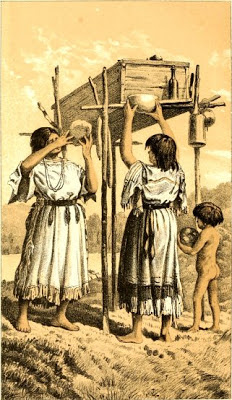
“KEEPING THE GHOST.”
Still another custom, though at the present day by no means generally followed, is still observed to some extent among them. This is called wanagee yuhapee, or “keeping the ghost.” A little of the hair from the head of the deceased being preserved is bound up in calico and articles of value until the roll is about two feet long and ten inches or more in diameter, when it is placed in a case made of hide handsomely ornamented with various designs in different colored paints. When the family is poor, however, they may substitute for this case blue or scarlet blanket or cloth. The roll is then swung lengthwise between two supports made of sticks, placed thus × in front of a lodge which has been set apart for the purpose. In this lodge are gathered presents of all kinds, which are given out when a sufficient quantity is obtained. It is often a year and sometimes several years before this distribution is made. During all this time the roll containing the hair of the deceased is left undisturbed in front of the lodge. The gifts as they are brought in are piled in the back part of the lodge, and are not to be touched until given out. No one but men and boys are admitted to the lodge unless it be a wife of the deceased, who may go in if necessary very early in the morning. The men sit inside, as they choose, to smoke, eat, and converse. As they smoke they empty the ashes from their pipes in the center of the lodge, and they, too, are left undisturbed until after the distribution. When they eat, a portion is always placed first under the roll outside for the spirit of the deceased. No one is allowed to take this unless a large quantity is so placed, in which case it may be eaten by any persons actually in need of food, even though strangers to the dead. When the proper time comes the friends of the deceased and all to whom presents are to be given are called together to the lodge and the things are given out by the man in charge. Generally this is some near relative of the departed. The roll is now undone and small locks of the hair distributed with the other presents, which ends the ceremony.
Sometimes this “keeping the ghost” is done several times, and it is then looked upon as a repetition of the burial or putting away of the dead. During all the time before the distribution of the hair, the lodge, as well as the roll, is looked upon as in a manner sacred, but after that ceremony it becomes common again and may be used for any ordinary purpose. No relative or near friend of the dead wishes to retain anything in his possession that belonged to him while living, or to see, hear, or own anything which will remind him of the departed. Indeed, the leading idea in all their burial customs in the laying away with the dead their most valuable possessions, the giving to others what is left of his and the family property, the refusal to mention his name, &c., is to put out of mind as soon and as effectual as possible the memory of the departed.
From what has been said, however, it will be seen that they believe each person to have a spirit which continues to live after the death of the body. They have no idea of a future life in the body, but believe that after death their spirits will meet and recognize the spirits of their departed friends in the spirit land. They deem it essential to their happiness here, however, to destroy as far as practicable their recollection of the dead. They frequently speak of death as a sleep, and of the dead as asleep or having gone to sleep at such a time. These customs are gradually losing their hold upon them, and are much less generally and strictly observed than formerly.
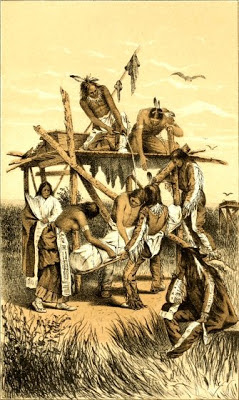
A. Delano,66 mentions as follows an example of tree-burial which he noticed in Nebraska.
During the afternoon we passed a Sioux burying-ground, if I may be allowed to use an Irishism. In a hackberry tree, elevated about twenty feet from the ground, a kind of rack was made of broken tent poles, and the body (for there was but one) was placed upon it, wrapped in his blanket, and a tanned buffalo skin, with his tin cup, moccasins, and various things which he had used in life, were placed upon his body, for his use in the land of spirits.
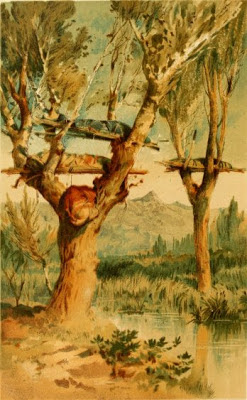
Complete Article ↪HERE↩!

